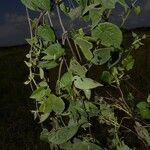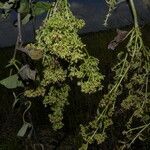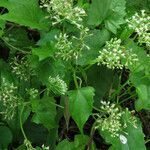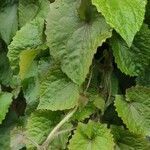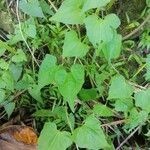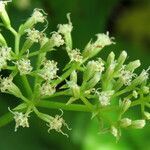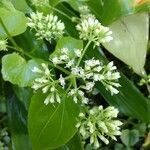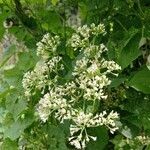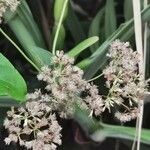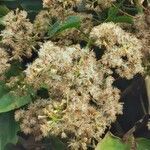Branched herbaceous to semi-woody vine to 6 m. Stems slender, terete to hexagonal, sparsely pubescent to glabrous, rooting at nodes. Leaves opposite; petiole 1–8 cm long; lamina ovate-deltoid, 3–13 cm long, 2–9 cm wide, cordate at base, entire to dentate, acuminate, trinerved, glabrous or sparsely glandular. Capitula in a mainly terminal corymbose panicle; peduncles 2–4 mm long; involucre narrow-campanulate; bracts in 2 series, oblong to obovate, 2–4 mm long, acuminate, glabrous to puberulous. Corolla c. 3 mm long, white. Achenes black, narrowly oblanceolate-oblong, c. 1.5–3.5 mm long, 4-or 5-ribbed, glandular, glabrous, or shortly scabrous on ribs. Pappus of elongated, erect, white scabrid bristles 2–4 mm long, persistent and shortly fused basally.
Vines, slender, branched. Stems yellowish or brownish, usually terete, slightly striate, glabrate to sparsely puberulent. Leaves opposite; petiole 1-6 cm; blade ovate, 3-13 × ca. 10 cm, both surfaces glabrate with numerous glandular spots, base cordate to deeply so, margin entire to coarsely dentate, apex shortly acuminate. Synflorescence a corymbose panicle, capitula clustered on subcymose branches; phyllaries oblong, ca. 3.5 mm, glabrous to puberulent, apex shortly acuminate; corollas white, 2.5-3 mm, tube narrow, limb broadly campanulate, inside papillate. Achenes 1.5-2 mm, 4-ribbed, with many scattered glands; pappus setae dirty white, ca. 3 mm. Fl. and fr. year-round. 2n = 36, 72.
A climber. It is a slender vine that branches. The stem are yellow. The leaves are opposite. The leaf stalks are 1-6 cm long. The leaves are oval and 3-13 cm long by 10 cm wide. The base is heart shaped. There can be coarse teeth along the edge.
